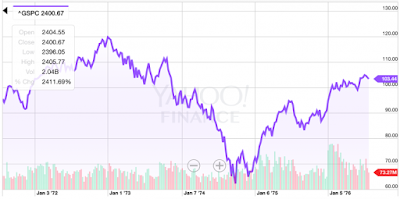The Market and Presidential Crisis
Here's what the stock market did during Watergate — and why
Excerpt:
Everyone these days seems to have one word on the tip of their tongues: Watergate. In the 1970s, the U.S. stock market endured one of the longest and most brutal bear markets in its history. After the Dow nearly topped 1,000 — topping out at 990 — for the first time in 1966, it would not regain this level on a closing basis until 1982. It would never trade below that level again.
In 1979, BusinessWeek famously published its cover declaring the “Death of Equities.” Inflation was running in double-digits while unemployment rose as “stagflation” riddled the economy.
In the months around Watergate, there was certainly political turmoil for investors to worry about, but the economic headwinds were far more problematic for the stock market, which endured one of its worst stretches in history. From the start of 1973 through Nixon’s resignation in August 1974, the S&P 500 fell about 50%. ...
Inflation ... was running in the double-digits. Consumer prices rose 3.6% from the prior year in January 1973. One year later, inflation was running at 9.6% year-on-year; by November 1974, inflation was up 12% year-on-year. Unemployment, meanwhile rose throughout 1974, eventually hitting 9% by May 1975.Comment: We were kind of in the market then but not strongly and we bailed out completely. We had a brokerage account and had perhaps 100 shares of the Southern Company. I also had bought several hundred shares of a solar company called Alpha Solarco. It failed. We worked for IBM then and bought shares of IBM through a stock purchase plan. In the Fall of 1976 we sold all and used the proceeds as a down payment on a house in Pittsburgh.
More: Impeachment of Trump "would blow the market away" (Jack Welch)
WSJ: Loose Lips Sink Presidencies



No comments:
Post a Comment
Any anonymous comments with links will be rejected. Please do not comment off-topic